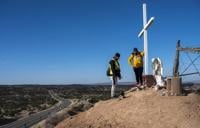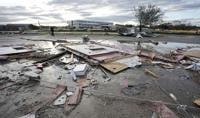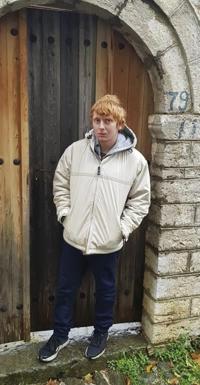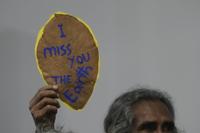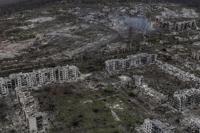Thousands of Catholics are making the trek to a historic adobe church in the hills of northern New Mexico as part of a Holy Week tradition that spans generations, carrying heavy wooden crosses and praying as they make their way through the high desert landscape.
El Santuario de Chimay├│ just north of Santa Fe is one of the most important Catholic pilgrimage centers in the U.S. Some travelers are drawn to the holy dirt, believed to have healing powers. Others come to see Nuestro Se├▒or de Esquipulas, a crucifix that, according to legend, was discovered at the site in the early 1800s.
Most pilgrims begin the journey on Good Friday, with state transportation workers, law enforcement agencies and other volunteers stationed along the roadways to ensure safety.
In an Easter message, Santa Fe Archbishop John Wester reflected Thursday on the season and urged the faithful to be mindful of how they can promote peace and help their neighbors.
ÔÇťWe are called to promote the sanctity of human life, to defend the rights of the oppressed, to search out the lost, and to offer prayers for the good of our church and the world,ÔÇŁ he wrote.
The Santa Fe Archdiocese is one of the oldest in the U.S. and is made up of many missions that date back centuries, to when Spanish conquistadors and the priests who traveled with them sought to convert to Christianity the pueblo people who lived throughout the Rio Grande Valley and surrounding areas.
Pueblo people who inhabited the Chimay├│ area long before the Spanish conquest believed that healing spirits were to be found in the form of hot springs. Those springs ultimately dried up, leaving behind earth many still believe to have healing powers.
A ║┌┴¤│ď╣¤═° Historic Landmark, El Santuario de Chimay├│ is decorated with original examples of 19th century Hispanic religious folk art, including santos and religious frescoes. The walls of one room are covered with notes of thanks from those who say they had ailments cured, while discarded canes and braces are meant to serve as proof that miracles happen at El Santuario.
In central New Mexico, pilgrims also make the trek to El Cerro de Tom├ę, a small hill that rises up from the Rio Grande floodplain. Three crosses sit at the top of the hill and hundreds of petroglyphs on the basalt rocks that make up the landmark serve as evidence that the spot has been a focus of ceremonies and prayers for centuries.
___
Montoya Bryan reported from Albuquerque, New Mexico.


